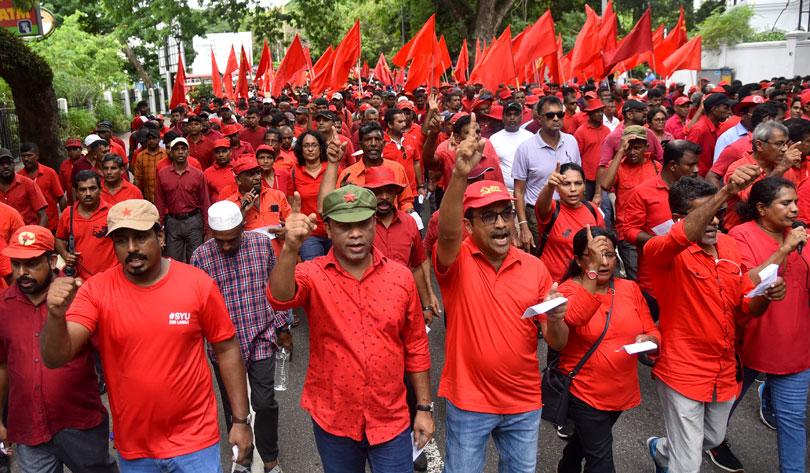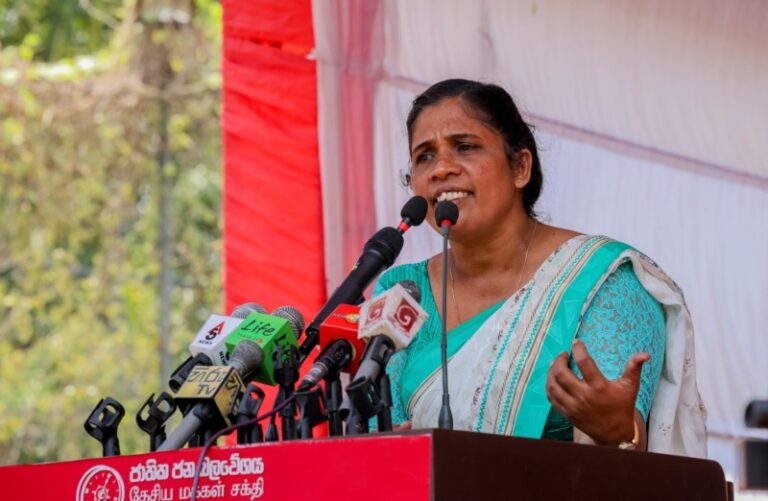Image: JVP May Day rally =not difficult to count the number of women!
Origin of Socialist Women’s Front
Pre-1971 JVP saw a presence of women cadres that could be considered modest. Before the April 1971 uprising there were full-time and part-time women cadres active within the “movement”. Among them were comrades such as Nandaseeli from Ragama, Seelawathi (comrade Osmund’s mother) from Wanathamulla, Kusuma Buddhikorala from Akuressa, Karuna (comrade Gamanayake’s wife) from Rambukkana, Kamani and Sampathi from Ambalangoda, Vitleen and Sujatha (Handagama) from the University of Peradeniya and Karuna from the University of Colombo. The Socialist Women’s Front laid the foundation necessary for women’s involvement in the JVP. Post-Uprising rebuilding efforts expanded the women’s network. Despite their contributions, leadership positions for women remained elusive, mirroring broader societal gender biases. After 1977, the organisation became known as the Socialist Women’s Union. Despite their presence, they were not elected or appointed as leading cadres within the organisation.
After the April 1971 Uprising, some women cadres left the organisation due to political differences, just like many male cadres. Yet, over time, the JVP was able to rebuild a large network of women cadres working as full-time and part-time activists. Unfortunately, the situation was not different to that of the pre-1971 period. None of the female cadres moved beyond from being members of the district committees. The JVP did not have a single female member at the party Central Committee and Politbureau. Compared to the abilities, awareness and activeness of the male cadres, the reason for women cadres being not elected or appointed to leadership positions can be understood in retrospect, only in terms of following the gender biases that prevailed in society at the time.
Political Landscape: Challenges and Opportunities
The JVP, though influential, faced challenges in mobilizing women compared to established parties who leveraged informal networks. The JVP had a strong political network among women, though it was not the robust among political organisations. The ruling political parties always had strong, but mostly informal networks among women. Those parties easily mobilized such networks during election times, to create political waves through the provision of short-term incentives. This was similar to the way the political elite made use of the religious, the trade unions and many rural organisations and networks.
Under those political circumstances, the inaugural Congress of the Socialist Women’s Front marked a pivotal moment in the history of women’s involvement in the JVP. It was held at the Sugathadasa Stadium in Colombo on January 7 and 8, 1982, with over 3,000 women party activists and sympathizers attending. Due to the internationalist stand the JVP had taken at the time, it was able to establish good relations with many national liberation movements and some of the countries who had been liberated from the colonial yoke.
There were two delegations in attendance, one from the Palestine Liberation Organisation and the other from the Ba’ath Socialist Party of Iraq. There were fraternal greetings offered by several movements fighting for their national liberation. Among them were Namibia and South Africa. Our hands of international solidarity had been extended to socialist movements in Vietnam, Kampuchea, and Laos and many other national liberation movements such as the ANC, PLO, FNLA in Angola, FRELIMO in Mozambique, ZANU in Zimbabwe, Fretilin, Polisario, EPLF in Ethiopia, FSLN in Nicaragua, FMLN in El Salvador, and MIR in Chile. Hosting international delegates underscored the JVP’s commitment to global solidarity.
Sadly, the higher echelons of the party including comrade Rohana Wijeweera took an opportunistic stance subsequently and shifted towards an exclusive nationalism that compromised the party’s internationalist position. Comrade Upatissa Gamanayake followed him due to a lack of understanding of the importance of internationalism in the world-wide struggle against neo-colonialism. Later on, the JVP became strongly entangled in a nationalism bordering on chauvinism. Comrade Rohana who wrote the publication, “Proletarian Internationalism or Opportunism?” became a champion of advocating this nationalist outlook through his later writings. That is why, since 1984, there was a total lack of expression of solidarity towards national liberation movements the world over.
Compared with the pre-1984 JVP, a slight progress in terms of gender inclusivity can be noticed. The NPP is seen to be doing better in this regard.
Contemporary Progress and Persistent Gaps
The current JVP and the National People’s Power (NPP) exhibit varying degrees of gender inclusivity. The JVP has its own separate political organisation. The NPP represents a broader front comprising 21 diverse groups, inclusive of several progressive organisations in the country. The organisational structure of the JVP appears to follow the standard Leninist model, though as an outsider, I cannot comment on its internal organisational make up and methodologies employed. The JVP has a Central Committee of 28 members, six of which are in the Politbureau. Of the Central Committee members, two are women, and the Politbureau has no women members. Compared with the pre-1984 JVP, a slight progress in terms of gender inclusivity can be noticed. The NPP is seen to be doing better in this regard. The organizational structure of the NPP comprises a National Executive Committee established on the basis of District Executive Councils. The Executive comprises 68 members of which seven are women, i.e., a percentage of about ten.
Despite the persistence of disparities, there are certainly marked improvements in a comparative sense. Both the current JVP and the NPP are doing better in terms of women’s participation, especially in the policy making structures than the pre-1984 JVP. But there is still a long way to go. Women constitute 52percent of Sri Lanka’s population; yet female representation in the Sri Lankan parliament is only 5.3 percent. This figure in no way reflects the population’s diversity. Political parties need to prioritize the issue of women’s leadership in order to effect meaningful change.
Realizing women’s political empowerment demands a systemic change that transcends inherent prejudices.
One could argue that the numerical strength of gender representation may not be so relevant. However, in terms of a qualitative transformation, to neglect the fact that 52 percent of the population is not sufficiently represented at the leadership level displays a clear drawback on the way the organisation approached political work. Again, in comparison, the leaderships of the major political parties in Sri Lanka cannot be said to be doing better in terms of gender representation. Both the JVP and the NPP have quite a long way to go if they are to reflect a proper representation of women. However, this could be compensated by the qualitative commitment and contribution the women’s leadership makes to build a better society and transform Sri Lanka into a better country.
Pathways to Empowerment: Initiatives and Challenges
Realizing women’s political empowerment demands a systemic change that transcends inherent prejudices. A process of successful empowerment of women involves them having a sense of self-worth; possessing the right to determine and have choices, the right to have access to opportunities and resources, the power to control their own lives and the ability to influence the direction of social change for creating a better and fairer social and economic order. There are a number of structural and ingrained prejudices about the role of women that need to be overcome to fully realise this goal.
Recent legislative debates, like proposed amendments to deal with sexual consent, highlight the persistent resistance against entrenched biases. Sexual harassment has been a part of the social and political culture of Sri Lanka. More recently, a bill to amend Sections 363 and 364 of Chapter 19 of the Penal Code of Sri Lanka was gazetted.
According to the current law, even if a girl under 16 years of age has sexual relations of her own free will, it is considered rape. With the new amendments, if a girl between the ages of 14 and 16 has sexual relations with a person under the age of 22 with her consent, there will be no legal retribution against him. This amendment has been proposed under the purview of Minister of Judicial Affairs and Constitutional Reform. The Forum of Sri Lankan Women Parliamentarians has opposed this amendment. The National Child Protection Authority of Sri Lanka has also advised the government that they do not agree with the proposed amendment. The Leader of Opposition has called for a review of the government’s decision. Whether the Minister has responded to these concerns is not yet known.
Actions to transform the governance and bureaucratic structures and institutions that reinforce and perpetuate gender discrimination and inequality are important tools for empowering women to claim their rights.
Lessons Learned and Future Directions
Examining and honestly discussing past incidents, such as internal disputes over women’s roles, illuminates the journey toward true empowerment of women. Confronting nationalism’s pitfalls and fostering international solidarity remains imperative in overcoming societal biases. For, embracing diverse voices and transformative actions will pave the way for a more equitable and inclusive political landscape. Advocacy, awareness, and quota systems offer pathways forward, which can help overcoming the existing economic and cultural barriers.
Women and their allies could exert pressure on the government and bureaucracy against gender discrimination and other practices that demean women. For this to happen the country’s political culture needs to change both quantitatively and qualitatively. A quota system that brings more politically conscious women in politics will be of immeasurable help for this to happen. Also, society needs to become better aware of the real issues that women are confronted with. Empowerment of women will also contribute to better socio-economic and cultural gains for all.
Conclusion
Celebrating International Women’s Day in Sri Lanka showcased both the progress and persistent challenges in achieving gender equality, particularly within political movements such as the JVP. Reflecting on the JVP’s past efforts, will allow delving into the historical context and contemporary dynamics. Thus, achievements can be appreciated while endeavouring to address the lingering disparities. In this context, it will be of extreme importance to provide better opportunities for awareness raising, building self-confidence, and expansion of choices available, provide better access to education, training and development opportunities, and control over the resources that they will need.
Actions to transform the governance and bureaucratic structures and institutions that reinforce and perpetuate gender discrimination and inequality are important tools for empowering women to claim their rights. Interventions with this in mind will provide practical means to uplift lives of vulnerable communities, particularly in rural areas, with a focus on women’s economic empowerment. This will enhance their capacity by promoting women’s productivity and sustainability, thus, contributing to economic recovery.
Empowering women politically is not an exercise involving numbers alone, but also about fostering a culture of inclusivity, respect, and equality. By confronting prejudices, amplifying women’s voices, and advocating for systemic change, a brighter, more just and equitable future for all can be built.
Concluded.
March 28, 2024

